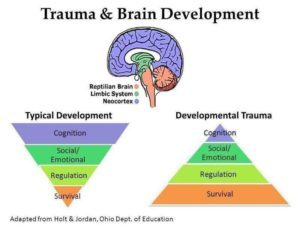In this post, I’m going to talk to you about childhood trauma. I’ll speak about how to work with children who have experienced trauma in my next article (here).
If you read my about me you saw that I am very passionate about bringing awareness of childhood trauma to everyone! I also want to help the kids by intervening where I can and teaching others how to do the same.
Before I get into that, I’ll briefly explain what childhood trauma is.
What is childhood trauma?
Trauma occurs from an event that is particularly impacting and stressful to the person and they have a lack of internal or external resources to cope appropriately (van der Kolk, 1989). Childhood trauma results from the same experience, except the event occurs in childhood, so from age 0 to 18 years of age.
Another term, somewhat synonymous with childhood trauma, is adverse childhood experiences. This originated from a study conducted by CDC and Kaiser. They essentially found links between trauma and physical health. That information can all be found on this website.
They found that approximately 50% of the adults they studied, had at least one traumatic experience in their childhood. They also found that about 25%, had two or more experiences and those with the most ACEs, demonstrated the biggest functional effects.
If you break that down, that means that 1 in 4 children will be functionally impacted by trauma.
Future research revealed similar statistics and all focused on varied socioeconomic backgrounds. Basically, it’s not just those in living in poor conditions.
So what are these “experiences” described in the study?
Here is the classification of what an adverse childhood experience or ACE is. They included these categories in the original research:
- Physical abuse
- Sexual abuse
- Verbal/emotional abuse
- Neglect
- Family member who faces mental illness or substance abuse
- Family member incarceration
- Witnessing domestic violence
- And loss of a parent due to divorce or possible death
This later expanded to include community violence, involvement in foster care, natural disasters, deportation, bullying by peers or adults, and a few others. Again, you can find all that information here.
What are the day-to-day impacts of childhood trauma?
There are a lot of technical answers to that question hidden within a lot of scientific research. Most notably are research studies by Dr. Nadine Burke Harris and Dr. Bessel van der Kolk.
Both of their books are phenomenal and talk about how trauma impacts development and a child’s neurological, social, and emotional responses. Dr. Bessel van der Kolk’s book is entitled, The Body Keeps the Score: Brain, Mind, and Body in the Healing of Trauma. Dr. Nadine Burke Harris recently published, The Deepest Well, which is equally as informative and very easy to read for the general public and health professionals. Both are easily available for purchase online and highly recommended.
The Gazelle and the Lion
For the purpose this setting, I used an analogy to describe trauma and its effects. I’ve heard this in passing used to discuss fight, flight or freeze, I believe this stems from Peter Levine’s book in 1997 Waking the Tiger: Healing Trauma. I’ve adapted it and taken it a step further to describe chronic trauma and the difference between someone who has experienced trauma and who hasn’t.
I want you to think of a gazelle in the plains who is known prey to a lion. The gazelle is constantly on guard for an incoming lion, because they know they are in danger if one is around. They need to be able to react at a moment’s notice in order to survive. If the gazelle has encountered multiple lions and a few close-encounter experiences, it is likely the gazelle will be more on guard than a gazelle who has never run into a lion on the plains or has seen fewer in their lifetime. If the gazelle almost died or perceived they almost died, they may have serious implications as well.
The gazelle may still react this way, whether in the presence of a lion or not.
In this instance, the gazelle is the child and the lion is the trauma.
A child who has experienced trauma is on guard for anything that may come their way. They know, from experience, they have to react in order to survive. Their brain is constantly telling them that their bodies are not safe, even if that is not always true. Their brain perceives a lot more stimuli as a threat than a child’s brain does that hasn’t experienced trauma. This could lead to aggression, trouble concentrating, trouble sleeping and many others that I’m sure you can imagine from being focused on solely survival.
If you look at the hierarchy of needs, basic survival is always at the bottom. However, it isn’t usually a priority for children and the need is easily met. As you can see in the diagram, survival (the orange) is the ultimate focus for children who have experienced trauma.

(http://www.scopeconsultancy.com.au/uncategorised/trauma-brain-development-children/)
Summary
So, there you have it. That’s a brief synopsis of childhood trauma and its impacts. I hope you left with a better understanding of just how important it really is and why everyone should be informed.
1 in 4 children are experiencing lifelong effects from traumatic experiences. With the rise of natural disasters and incidences of community violence, I’m guessing the number will only increase. This is something we need to get involved in. And we can!
Stick with me and I will talk about how you can help in the next post.
Thanks for stopping by! Please share your comments below!
~ Taelor
References:
van der Kolk, B. A. (1989). The compulsion to repeat the trauma: Re-enactment, re-victimization, and masochism. Psychiatric Clinics of North America, 12, 389–411.